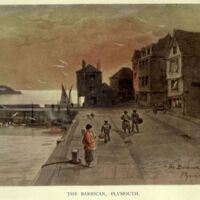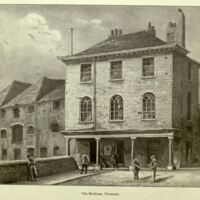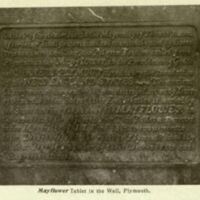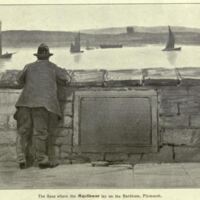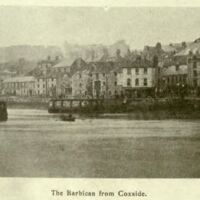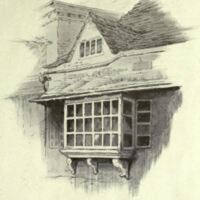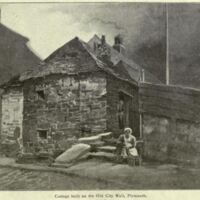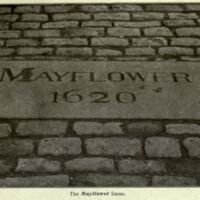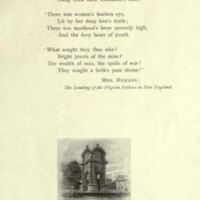Subject
In the final chapter of Homes and Haunts of the Pilgrim Fathers Mackennel visits Plymouth and recounts the last place the ‘Pilgrim Fathers’ saw before they embarked towards the New World. This chapter is extensively illustrated by Whymper and accompanied with photographs. As with much British Mayflower writing, history and myth are blurred; Mackennel asserts that ‘they gave the name of Plymouth Rock to their landing-place’ in reference to their last port of call in the Old World. In reality, Plymouth Rock was guesswork on the part of a later generation of New Englanders hoping to commemorate their forefathers. There’s no evidence that original separatists named a stone near their landing-site ‘Plymouth Rock’. Moreover, the emotion and pathos common in retellings of the narrative is evident in this closing section, as Mackennal notes: “They never forgot their English homes; indeed, as always with the human heart, distance and time deepened their love for the land they had left, for the haunts of childhood, for the green fields and headlands that faded last out of view”. The book closes with an extract from Hemans' famous poem 'The Landing of the Pilgrim Fathers' in New England. Nearly a century later, the same seniments are expressed by Mackennel.
“The spot where the Mayflower actually lay is now marked by a stone tablet bearing the simple words, 'Mayflower, 1620'; and it is clear that the present projecting quay could not have been there at that day. But we hardly grudge the alteration, as it enables one to stand comfortably over the very spot once water where this historic craft was moored; and we appreciate, too, the kindly forethought of those who have marked so interesting a place. Let into the adjacent wall is a metal memorial tablet, recording in the following words the incident, in 1620 apparently so insignificant, but fraught with consequences of such incalculable importance: 'On the 6th of September, 1620, in the Mayoralty of Thomas Fownes, after being " kindly entertained and courteously used by divers Friends there dwelling," the Pilgrim Fathers sailed from Plymouth in the Mayflower, in the Providence of God to settle in New Plymouth, and to lay the Foundation of the New England States. The ancient Causey whence they embarked was destroyed not many Years afterwards, but the Site of their Embarkation is marked by the Stone bearing the name of the Mayflower in the pavement of the adjacent Pier. This Tablet was erected in the Mayoralty of J. T. Bond, 1891, to commemorate their Departure, and the visit to Plymouth in July of that Year of a number of their Descendants and Representatives.'
Here, as elsewhere, we could wish that more had been told us of their days in Plymouth their last English days. What scenes they visited, what friends they met, we now may not know. But they remembered in after years the hospitality of Plymouth people, and make grateful mention of it; when they landed on the other side, they gave the name of Plymouth Rock to their landing-place. They never forgot their English homes; indeed, as always with the human heart, distance and time deepened their love for the land they had left, for the haunts of childhood, for the green fields and headlands that faded last out of view. But they were architects of the future; regrets made way for endurance and achievement. The men and women on board the Mayflower were exiles of freedom the noblest freedom of all, the free communion of the human spirit with the Spirit of God. They were human, like all their fellows of all time ; but they loved liberty for others as well as for themselves, as far as ever their light led them. Many followed them across the sea in after years, with less toleration for others ; sometimes readers in haste to find ground of censure have inflicted on these first pioneers blame that just belongs to later emigrants who came in another spirit. It will be well, if, forgetting much that divides Christian churches, Christ's own on both sides of the Atlantic should seek, as from 1920, to draw nearer each other in heart and spirit. And still more that these two peoples, lifted into such supreme responsibility in the guidance of the world's future, may together, as in another mightier Mayflower, through, it may be, more stormy seas, bring the whole of our human world into a safe haven of peace and good-will.”

